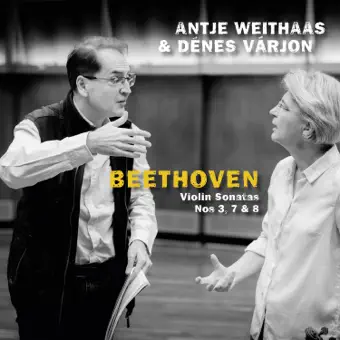januari 2024
Beethoven: Violin Sonatas Nos. 3, 7 & 8
Antje Weithaas & Dénes Várjon
Antje Weithaas en Dénes Várjon zijn terug met een tweede deel met sonates van Beethoven, en daarin ontdekken ze zijn muziek met oprecht inzicht, wat rijke beloningen oplevert.

Ik vond veel om te bewonderen in het eerste deel van Antje Weithaas en Dénes Várjons overzicht van de vioolsonates van Beethoven (7/23), hoewel ik vond dat hun zachtere spel vertrouwelijker had kunnen zijn. Ik heb geen dergelijke kritiek op dit tweede deel. Luister bijvoorbeeld naar Várjons aangrijpende sotto voce aan het begin van de c mineur Sonate, Op 30 nr. 3 – en let ook op de manier waarop hij ogenschijnlijk fermata's over de rusten plaatst, de stiltes verlengend om het drama op te voeren. Ik hou ook van hoe zacht en aanhoudend hun spel is op 2'12", een buitengewone passage waarvan de harmonische verschuivingen Schubert lijken aan te kondigen op zijn meest lyrisch welbespraakte en visionaire. Luister dan, in de warmte van het Adagio cantabile, naar hoe Weithaas het meeste haalt uit de vreemde, wilde vogelgeluiden (op 4'40").
Het is inderdaad het vermogen van het duo om zo fantasierijk te karakteriseren dat deze interpretaties zo bevredigend maakt. Ik heb de trillers in het eerste deel van de sonate in G majeur, Op. 30 nr. 2, nog nooit zo verraderlijk horen klinken als hier, bijvoorbeeld – probeer het eens aan het begin van het ontwikkelingsgedeelte (vanaf 3'55"). En ze zijn ongewoon vrij met het tempo van het tweede deel Tempo di minuetto, wat een element van fantasie in deze anders zo galante muziek injecteert. Evenzo, hoewel ze het openingsdeel Allegro con spirito van Op. 12 nr. 3 met onfeilbare elegantie (en een gestaag tempo) spelen, is er iets uitgesproken rhapsodisch in de manier waarop ze de verschillende virtuoze roulades van de muziek behandelen.
Wees gerust, er wordt geen poging gedaan om deze werken mooier te maken – die gigantische fortissimo akkoorden in het eerste deel van de sonate in c mineur hebben bijvoorbeeld een passende crunch – hoewel wat mij het meest opvalt op deze cd de ongestudeerde verfijning is van hun spel en hun waardering voor de subtiliteiten van de muziek. Hoe vrolijk en lichtvoetig hun lezing van de finale van de Sonate in G majeur is, zeg maar, zelfs in de coda, waar de harmonische en motivische fratsen met smaak en humor worden behandeld. Als de daaropvolgende delen zo gepolijst en fris inzichtelijk zijn als deze, dan zal de cyclus van Weithaas en Várjon er een zijn om rekening mee te houden.

I found much to admire in the first instalment of Antje Weithaas and Dénes Várjon’s survey of the Beethoven violin sonatas (7/23), although I felt their softer playing could have been more confidential. I’ve no such quibbles with this second volume. Listen, say, to Várjon’s arresting sotto voce at the beginning of the C minor Sonata, Op 30 No 3 – and note, too, the way he ostensibly puts fermatas over the rests, extending the silences in order to ratchet up the drama. I also love how soft and sustained their playing is at 2'12", an extraordinary passage whose harmonic shifts seem to presage Schubert at his most lyrically eloquent and visionary. Then, in the warmth of the Adagio cantabile, listen to how Weithaas makes the most of the weird, wild birdcalls (at 4'40").
Indeed, it’s the duo’s ability to characterise so imaginatively that makes these interpretations especially satisfying. I’ve never heard the trills in the first movement of the G major Sonata, Op 30 No 2, sound as insidious as they do here, for instance – try at the beginning of the development section (from 3'55"). And they’re unusually free with the tempo of the second-movement Tempo di minuetto, injecting an element of fantasy into this otherwise galant music. Similarly, although they play the opening Allegro con spirito of Op 12 No 3 with unfailing elegance (and a steady tempo), there’s something distinctly rhapsodic in the way they handle the music’s various virtuosic roulades.
Rest assured that no attempt is made to prettify these works – those giant fortissimo chords in the first movement of the C minor Sonata have an appropriate crunch, for example – although what stands out most for me on this disc is the unstudied refinement of their playing as well as their appreciation of the music’s subtleties. How joyful and light on its feet their reading of the finale of the G major Sonata is, say, even in the coda, where the harmonic and motivic high jinks are handled with taste as well as wit. If the subsequent volumes are as polished and freshly insightful as this, Weithaas and Várjon’s cycle will be one to reckon with.
